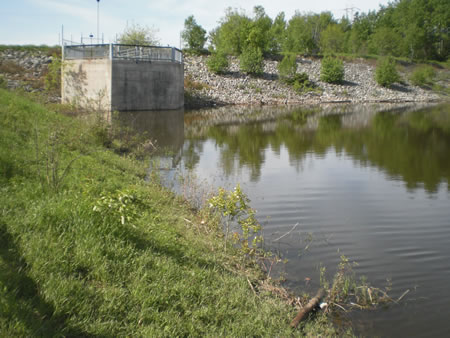The Fort Creek Dam and Reservoir project began in late 1967 and was completed in 1971. It was officially dedicated in September 1971 by George Kerr, Provincial Minister for the Environment. Mayor John Rhodes and Sault M.P.P. Arthur Wishart were also among the other dignitaries who attended the ceremonies. 500 youngsters planted spruce trees at the site to commemorate the event.


The drainage area for the dam is approximately 7.7 square kilometres, while the reservoir surface area is 3.24 hectares. The Fort Creek Flood Control Channel is 0.46 km in length.
The dam is an earthen structure with a low permeability clay core confined by shells of granular material. The dam is 12 metres high and 117 meters long. The outlet consists of a 0.9 metre wide gate and a 91.4 metre long chute spillway passing through the base of the dam. There is also a hexagonal shaped concrete drop inlet structure/overflow weir and a broad emergency overflow spillway, temporarily blocked by a series of erodible berms with clay cores and granular shells (fuse plugs).
Downstream from the dam, the Fort Creek channel crosses Second Line and John Street. Further downstream, Fort Creek is enclosed in a concrete aqueduct from Hudson Street near Wellington Street to Queen Street near John Street. The lower portion of Fort Creek is an open channel south of Queen Street to the St. Mary’s River.


Prior to construction of the Fort Creek Dam, major flooding occured in Sault Ste. Marie as Fort Creek overflowed it banks. The flooding occured in populated areas where existing aqueducts did not have sufficent drainage capacity to convey peak runoff. Consequently, the primary object of the Fort Creek Dam was to provide flood control. The dam functions by retaining run-off from a rain event and subsequently releasing it when downstream flows have subsided.











